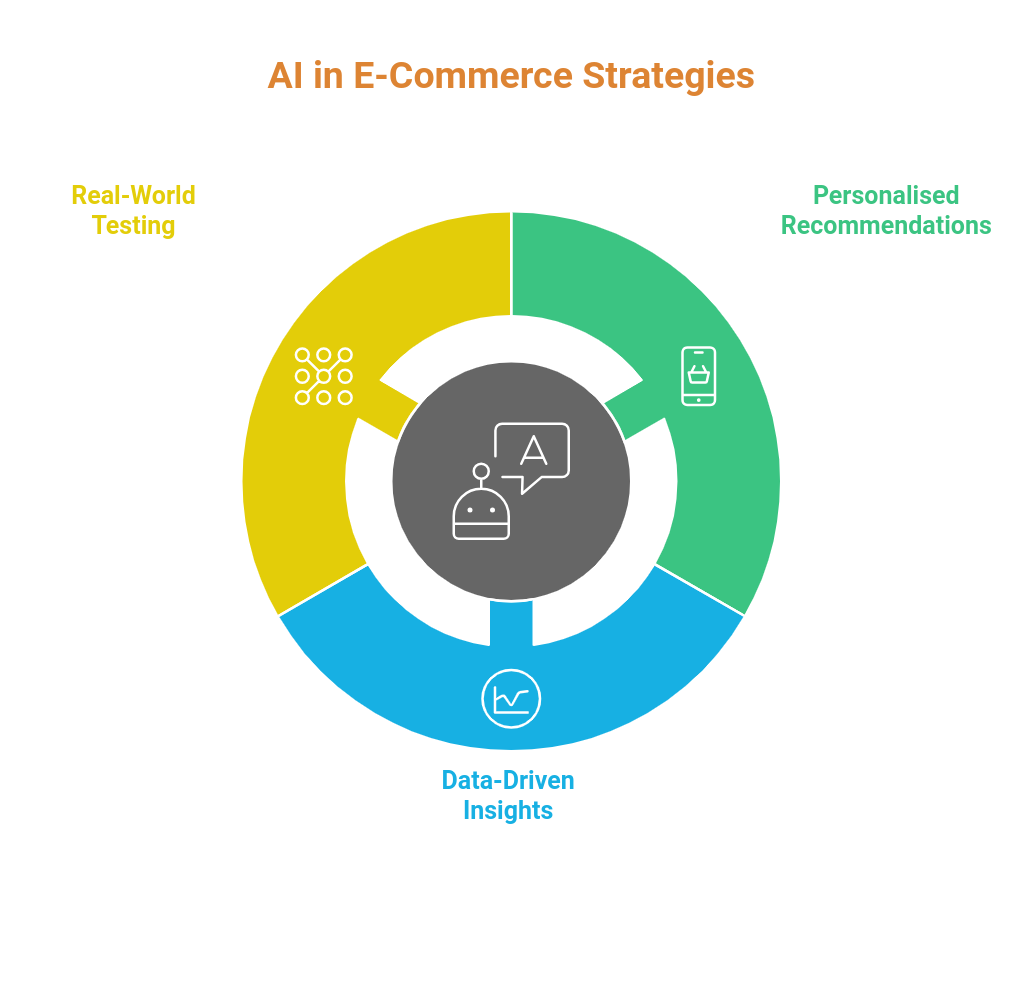In the competitive world of e-commerce, cross-selling and upselling are pivotal strategies for boosting revenue and improving customer lifetime value (CLV). However, achieving precision in these tactics can be challenging for small businesses. Enter artificial intelligence (AI), a game-changer that empowers small e-commerce businesses to deliver personalised, data-driven recommendations. In this article, we’ll dive into how AI can transform your cross-selling and upselling strategies, complete with actionable insights and real-world examples.

Customer Segmentation and Insights
The foundation of effective cross-selling and upselling lies in understanding your customers. AI enables businesses to analyse vast amounts of data, including purchase history, browsing behaviour, and engagement metrics. This creates a detailed picture of customer preferences, allowing for hyper-targeted strategies.
How AI Drives Customer Segmentation
Machine learning models can segment customers into groups based on shared characteristics, such as buying patterns or demographic data. For example, a small e-commerce store selling home goods might identify a segment of customers who frequently purchase kitchenware but rarely buy décor items.
“AI-powered segmentation unlocks the ability to deliver the right message to the right customer at the right time.” – Bill Forrester, CEO of AI Commerce Solutions
By leveraging predictive analytics, businesses can also anticipate future customer needs. For instance, AI might predict that customers purchasing a coffee machine are likely to buy coffee pods within the next month.
For more on customer segmentation, check out our guide on effective segmentation strategies.
Personalised Recommendations
One of AI’s most powerful applications in e-commerce is its ability to offer personalised product recommendations. Recommendation engines use machine learning algorithms to analyse customer behaviour and suggest products that align with their preferences.
Real-Time Recommendations
AI enables real-time recommendations, dynamically adjusting suggestions based on the customer’s current actions. For example, if a customer adds a camera to their cart, the system might recommend a tripod or a memory card as complementary items.
- Upselling: Recommending a premium version of the product.
- Cross-selling: Suggesting related or complementary products.
Amazon’s recommendation engine, which generates 35% of the company’s revenue, is a prime example of this strategy in action (source).
Predictive Analytics
Predictive analytics takes historical data and applies machine learning to forecast future behaviours. This allows small businesses to identify customers most likely to respond positively to cross-sell or upsell offers.
Customising Offers
With predictive analytics, you can tailor your offers to maximise their impact. For instance, if data indicates a customer frequently buys organic products, you can recommend premium organic items or bundle them with complementary products.
Timing is also critical. AI can determine the optimal time to present an offer, such as during checkout or in a follow-up email. Learn more about email marketing strategies in our article on email marketing automation.
Dynamic Pricing and Promotions
AI-driven dynamic pricing strategies analyse variables like supply and demand trends, competitor pricing, and customer purchasing power to optimise pricing. This ensures you remain competitive while maximising profitability.
Personalised Promotions
AI can also personalise promotions based on customer segmentation. For example, a loyal customer might receive a discount on a premium product, while a new customer might be offered a bundle deal to encourage additional purchases.
Tools like HubSpot’s AI tools can help automate these processes, saving time and resources.
AI Chatbots for Engagement
AI chatbots are becoming essential tools for e-commerce businesses. They can engage customers at key moments, such as during checkout or when browsing specific categories, to suggest relevant products.
Dynamic Product Bundling
Chatbots can also create dynamic product bundles based on the items in a customer’s cart. For instance, if a customer adds a laptop to their cart, the chatbot might suggest a bundle that includes a laptop sleeve and a wireless mouse.
For tips on implementing AI chatbots, check out our article on AI chatbots for e-commerce.
Benefits of AI in Cross-Selling and Upselling
By leveraging AI, small e-commerce businesses can achieve significant benefits, including:
- Increased Revenue: Relevant recommendations boost average order value.
- Higher Customer Lifetime Value: Encouraging additional purchases maximises long-term revenue.
- Improved Customer Experience: Personalised offers enhance satisfaction and trust.
- Enhanced Customer Loyalty: Accurate suggestions build stronger relationships.
Real-Life Examples and Best Practices
Successful examples of AI-driven cross-selling and upselling include:
- Amazon: Suggesting complementary items like phone cases with smartphones.
- Netflix: Recommending premium subscription plans based on viewing habits.
- Sephora: Using chatbots to suggest makeup bundles tailored to customer preferences.
To implement these strategies, focus on training your AI tools effectively and integrating them seamlessly into your sales and marketing processes.
Conclusion
AI has revolutionised cross-selling and upselling, making it more precise, personalised, and impactful. By leveraging customer data, predictive analytics, and AI-driven tools, small e-commerce businesses can enhance revenue, improve customer satisfaction, and foster loyalty.
Now is the time to adopt AI strategies in your e-commerce operations. Start small, test various tools, and refine your approach to maximise results. Ready to take the next step? Explore our AI tools for e-commerce to get started.

